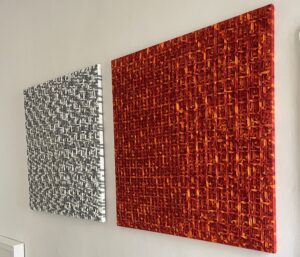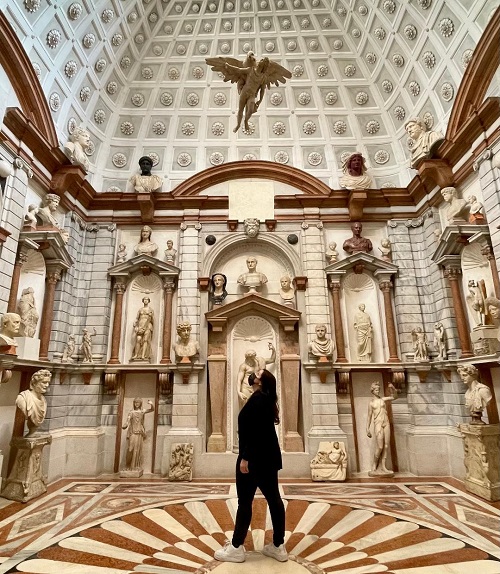The network is what best identifies our present, our society and our way of interacting. Reality is identifiable by means of a network of interconnections and the way in which they occur determines the “system”, understood as a whole formed by interacting elements between them, which is formed. The most recent works by Fernando Garbellotto, on display at Palazzetto Tito – Fondazione Bevilacqua La Masa until October 9th, lead those who observe them to an immediate reflection on this specific concept of network and system.
We find ourselves in front of a series of three-dimensional fractal patterns, a regular compositional scheme, sometimes monochromatic and sometimes multicolored, of which, however, the artistic purpose is not instantly clear. These are works, a little more than twenty in total, consisting of intertwinings that are repeated in a solution of continuity, formed by strips of painted canvas tied together according to a precise interval, the one that makes up the “system” of the single work. In general, what is created is, therefore, a real network, an image that concretizes the way systems relationships happen to each other.
If, at first reading, all this seems complex, in front of the work these words will assume the meaning that the exhibition, from the eloquent title «Fractal networks; systems in relation», it was proposed to communicate: The nodes of Fernando Garbellotto should not be considered in their singularity, but in the whole and in the interaction that occurs between them. The nodes not only form a pattern on the surface of the work but are themselves a pattern. The canvas, a possible metaphor of life and society, is painted, cut into regular strips that are knotted together and mounted, finally, on a frame, causing in the observer the visual and perceptive vibration of this interconnection that protrudes beyond the surface of the work.
The artist’s vision and, consequently, his language make use of studies that reflect on «objects as networks of relationships inserted within larger networks» as stated by Claudio Cerritelli, curator of the exhibition catalogue, allowing us to understand how these fractal networks, in the variations of their characteristics, are able to synthesize our time and express the interaction relationships that we find ourselves living every day. While maintaining the constancy between the intervals of the fractal nodes, it is possible to notice, from work to work, both chromatic and rhythmic diversifications, and therefore of weaving, which has narrower or wider textures, as also the overlapping layers of the nets vary.
A striking example of this is the works in the room dedicated to the reflection on the famous sequence of Fibonacci, the sequence of integers in which each number is the sum of the previous two. Here the artist represents the sequence by means of a selection of six works that, while presenting all the alternation of white and black knotted fabrics, form bands of color that follow the sequence studied by the Pisan mathematician, therefore changing their intervals respectively, increasing their dimensions on the frame.
The fractal networks exhibited in the other rooms have modular units and compositions apparently untied, in which the “fractal alphabet” of Garbellotto develops through doubling of plots that align in a transversal and orthogonal, play with sometimes unusual combinations of colors or exploiting the stability of monochrome. The two-dimensionality is overcome by the various overlapping layers of the texture created by the fractal nodes, conceived by the artist as worlds in relation that have the task of attracting those who look at them in the flow created by the grid of the network.
The result is a journey through the intertwining of different compositions, sizes and shapes, from the square to the rectangle to the curvilinear shapes, in which the scheme of each work is a world in itself, while remaining interconnected and united to the others for the mode of creation.
If the information in the room were not enough to understand the works exhibited in the historic setting of the Bevilacqua La Masa Foundation, Fernando Garbellotto is committed to guiding visitors during a few days of free visits whose dates can be found in the institution’s Instagram account.
Info:
Fernando Garbellotto, Reti frattali; sistemi in relazione
2/09 – 9/10/2022
Palazzetto Tito, Dorsoduro 2826
Fondazione Bevilacqua La Masa, Venice
 Fernando Garbellotto, Rete frattale – 530 KN, Rete frattale – 716 KN, courtesy Fernando Garbellotto
Fernando Garbellotto, Rete frattale – 530 KN, Rete frattale – 716 KN, courtesy Fernando Garbellotto
 Fernando Garbellotto, Rete frattale – 1046 KN, courtesy Fernando Garbellotto
Fernando Garbellotto, Rete frattale – 1046 KN, courtesy Fernando Garbellotto
 Fernando Garbellotto, Sequenza di Fibonacci 1 – 816 KN, Sequenza di Fibonacci 2 – 834 KN, Sequenza di Fibonacci 3 – 834 KN, courtesy Fernando Garbellotto
Fernando Garbellotto, Sequenza di Fibonacci 1 – 816 KN, Sequenza di Fibonacci 2 – 834 KN, Sequenza di Fibonacci 3 – 834 KN, courtesy Fernando Garbellotto
 Fernando Garbellotto, Sequenza di Fibonacci 5 – 834 KN, Sequenza di Fibonacci 8 – 800 KN, courtesy Fernando Garbellotto
Fernando Garbellotto, Sequenza di Fibonacci 5 – 834 KN, Sequenza di Fibonacci 8 – 800 KN, courtesy Fernando Garbellotto

Passionate about curatorial practice and museology, she has always been interested in the history of art from the modern to the contemporary era. After an international university education in art history and conservation of historical-artistic heritage, she has dedicated herself to cultural influences and exchanges between Italy and France.






NO COMMENT